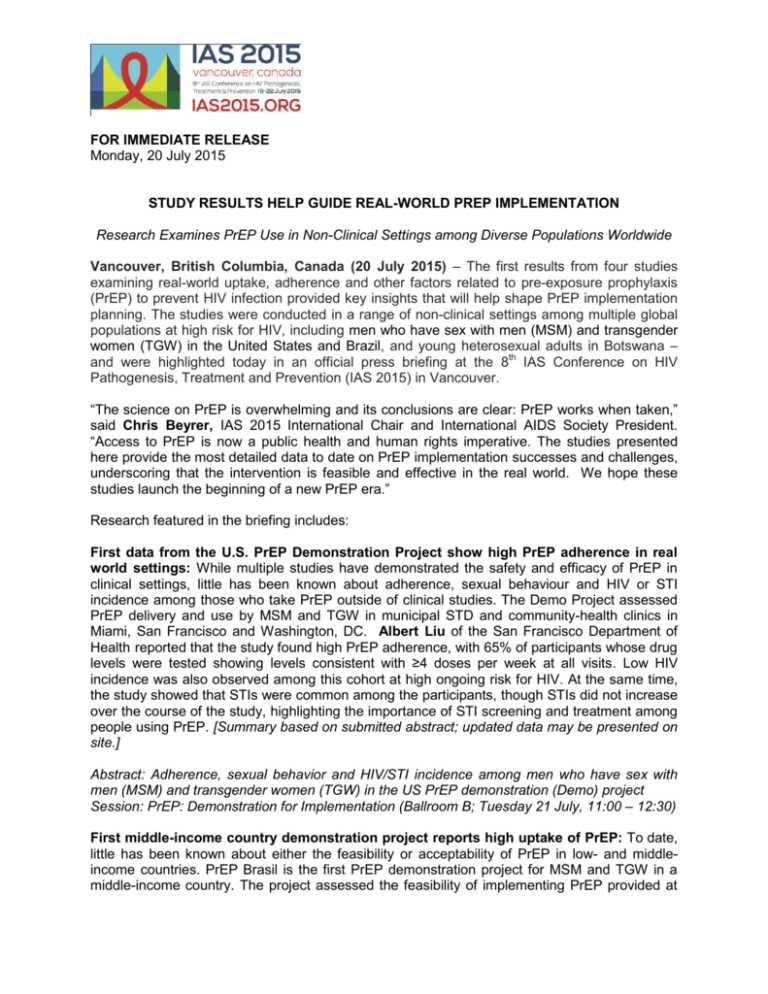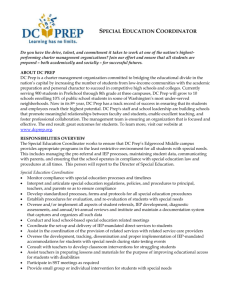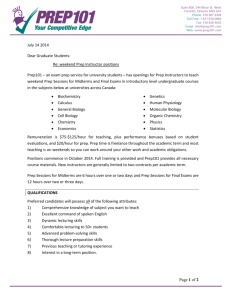
FOR IMMEDIATE RELEASE
Monday, 20 July 2015
STUDY RESULTS HELP GUIDE REAL-WORLD PREP IMPLEMENTATION
Research Examines PrEP Use in Non-Clinical Settings among Diverse Populations Worldwide
Vancouver, British Columbia, Canada (20 July 2015) – The first results from four studies
examining real-world uptake, adherence and other factors related to pre-exposure prophylaxis
(PrEP) to prevent HIV infection provided key insights that will help shape PrEP implementation
planning. The studies were conducted in a range of non-clinical settings among multiple global
populations at high risk for HIV, including men who have sex with men (MSM) and transgender
women (TGW) in the United States and Brazil, and young heterosexual adults in Botswana –
and were highlighted today in an official press briefing at the 8th IAS Conference on HIV
Pathogenesis, Treatment and Prevention (IAS 2015) in Vancouver.
“The science on PrEP is overwhelming and its conclusions are clear: PrEP works when taken,”
said Chris Beyrer, IAS 2015 International Chair and International AIDS Society President.
“Access to PrEP is now a public health and human rights imperative. The studies presented
here provide the most detailed data to date on PrEP implementation successes and challenges,
underscoring that the intervention is feasible and effective in the real world. We hope these
studies launch the beginning of a new PrEP era.”
Research featured in the briefing includes:
First data from the U.S. PrEP Demonstration Project show high PrEP adherence in real
world settings: While multiple studies have demonstrated the safety and efficacy of PrEP in
clinical settings, little has been known about adherence, sexual behaviour and HIV or STI
incidence among those who take PrEP outside of clinical studies. The Demo Project assessed
PrEP delivery and use by MSM and TGW in municipal STD and community-health clinics in
Miami, San Francisco and Washington, DC. Albert Liu of the San Francisco Department of
Health reported that the study found high PrEP adherence, with 65% of participants whose drug
levels were tested showing levels consistent with ≥4 doses per week at all visits. Low HIV
incidence was also observed among this cohort at high ongoing risk for HIV. At the same time,
the study showed that STIs were common among the participants, though STIs did not increase
over the course of the study, highlighting the importance of STI screening and treatment among
people using PrEP. [Summary based on submitted abstract; updated data may be presented on
site.]
Abstract: Adherence, sexual behavior and HIV/STI incidence among men who have sex with
men (MSM) and transgender women (TGW) in the US PrEP demonstration (Demo) project
Session: PrEP: Demonstration for Implementation (Ballroom B; Tuesday 21 July, 11:00 – 12:30)
First middle-income country demonstration project reports high uptake of PrEP: To date,
little has been known about either the feasibility or acceptability of PrEP in low- and middleincome countries. PrEP Brasil is the first PrEP demonstration project for MSM and TGW in a
middle-income country. The project assessed the feasibility of implementing PrEP provided at
no cost to high-risk MSM and TGW within that nation’s public health system. Study results
presented by Beatriz Grinsztejn of Instituto Pesq Clinica Evandro Chagas (IPEC) show high
PrEP uptake (51.25%) within the project, with higher uptake among those at increased risk and
with an existing awareness of PrEP, demonstrating that PrEP is most likely to be used by those
most in need. [Summary based on submitted abstract; updated data may be presented on site.]
Abstract: Pre-exposure prophylaxis (PrEP) uptake and associated factors among MSM and
TGW in the PrEP Brasil demonstration project
Session: PrEP: Demonstration for Implementation (Ballroom B; Tuesday 21 July, 11:00 – 12:30)
Botswana TDF2 Open-Label Extension reports strong adherence, high drug levels and no
HIV infections: Data from this 12-month open-label extension of the TDF2 study of PrEP
among young heterosexual adults in Botswana were reported by Faith Henderson of the U.S.
Centers for Disease Control and Prevention. The original TDF2 study completed follow-up in
2011, demonstrating 62% overall protective efficacy.
Researchers from the study’s open-label extension described high self-reported three-day
medication adherence (for the prior three days, 87.8% reported taking TDF/FTC daily, while
5.5% reported taking it 1-2 times and 6.7% reported taking none) and no HIV infections among
229 participants receiving PrEP. In a cohort of 30 participants randomly selected for dried blood
spot testing, a high percentage had detectable PrEP drug levels (at months 1, 3, 6, 9 and 12,
the proportions with detectable mean tenofovir levels were 93%, 93%, 100%, 93% and 90%,
respectively). Authors concluded that the findings lend support to efforts to expand PrEP
availability in the context of generalized epidemics in resource-limited settings. [Summary based
on submitted abstract; updated data may be presented on site.]
Abstract: Characteristics and oral PrEP adherence in the TDF2 open-label extension in
Botswana
Session: PrEP: Demonstration for Implementation (Ballroom B; Tuesday 21 July, 11:00 – 12:30)
Strong start on PrEP for a diverse population of young MSM in U.S., but more adherence
support may be needed: This open-label study examined PrEP uptake and adherence, as well
as sexual risk behaviour, among a diverse (54.5% Black, 26.5% Latino) group of young men
who have sex with men (YMSM) in 12 U.S. cities. YMSM, particularly racial/ethnic minority
YMSM, are at heightened risk for HIV in the U.S. Among the key study findings reported by
Sybil Hosek of Stroger Hospital, Cook County (Illinois): initial PrEP uptake in the cohort was
high, with the majority of participants (56%) achieving protective drug levels in their first monthly
study visit (week 4). As visits decreased in frequency (occurring monthly through week 12, then
quarterly through week 48), so did adherence, with 34% of participants showing blood levels
consistent with ≥4 PrEP pills per week by week 48. Condomless sex was reported by >80% of
participants throughout the study, but condomless anal sex with last partner was also
associated with higher PrEP drug levels, indicating that those at highest risk for HIV were also
adhering to PrEP. The study concluded that providing access to PrEP in youth-friendly settings
with tailored adherence support and augmented visit schedules may help to maximize the
impact of this prevention approach among this heavily affected population. [Summary based on
submitted abstract; updated data may be presented on site.]
Abstract: An HIV pre-exposure prophylaxis (PrEP) demonstration project and safety study for
young men who have sex with men in the United States (ATN 110)
Session: PrEP: Demonstration for Implementation (Ballroom B; Tuesday 21 July, 11:00 – 12:30)
2
Special PrEP-themed issue of JIAS: Also at today’s press conference, Carlos F. Cáceres of
the Universidad Peruana Cayetano Heredia presented a special issue of the Journal of the
International AIDS Society (JIAS) entitled, “PrEP Implementation Science: State-of-the-Art and
Research Agenda.” The PrEP-themed issue includes new data and expert commentary by
leading researchers that address different approaches to PrEP access and use, the potential
impact of PrEP in specific regions and countries and among different populations at risk for HIV,
as well as the political, economic and social issues raised by PrEP.
###
About IAS
Founded in 1988, the International AIDS Society (IAS) is the world’s largest association of HIV
professionals, with members from more than 180 countries. IAS members work on all fronts of
the global response to AIDS and include researchers, clinicians, policy and programme
planners, and public health and community practitioners.
About IAS 2015
The 8th IAS Conference on HIV Pathogenesis, Treatment and Prevention (19-22 July,
Vancouver) is the leading scientific meeting on HIV. IAS 2015 brings together a broad cross
section of more than 6,000 HIV professionals from around the world, with a focus on moving
science into practice.
IAS 2015: Join the Conversation
Get the latest conference updates and share your thoughts and ideas through the IAS 2015
Social Media channels.
We are tweeting – @IAS_conference and @iasociety – and hope many of you will tweet
along with us, using #IAS2015 to keep the conversation going.
Like IAS 2015 on Facebook – and stay in touch with the latest conference updates and
developments.
Check
us
out
on
Instagram
to
see
photos
as
they
are
happening! https://instagram.com/iasociety/
Tell us why you’re following IAS 2015 and what matters most to you. Join the IAS
Conference on HIV Pathogenesis, Treatment and Prevention group on LinkedIn. You
are welcome to start new discussions and add your comments to existing threads.
Contacts:
Kyle Murphy, +1 778 389 1695
kmurphy@corkeryunlimited.com
Rob Caruano, +1 778 386 3485
rcaruano@corkeryunlimited.com
www.iasociety.org | www.ias2015.org | www.aids2016.org
3








